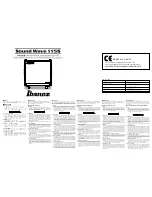
44
Adjust potentiometer AMP for correct indication.
17.2.2 PLATE VOLTAGE
Adjustment: VR2, marked: VOLT
Using a voltmeter with a high voltage probe, measure the plate voltage.
Adjust potentiometer VOLT for correct indication on the display.
17.2.3 REFLECTED POWER
Adjustment: VR3, marked: RF R
Make sure the amplifier is in STANDBY.
Reverse the input and output RF connections.
- connect the transceiver or exciter to the amplifier output
- connect the dummy load to the input of the amplifier
Apply 100W drive and adjust “RF R” for 100W indication
Reverse again the RF cable - connect them the right way.
17.2.4 FORWARD POWER
Adjustment: VR1, marked: RF F
On 20m, operate the amplifier at the full nominal power CW (4000 W), as indicated by an external power meter:
Adjust potentiometer “RF F” for correct display indication
17.2.5 SCREEN CURRENT
Adjustment: VR6, marked IG2+, VR5, marked IG2-
ig2+:
connect a mA meter in series with the screen supply, between the control board pin EG2 and the blue screen wire.
(See also the control board adjustment for IG2 LIMIT).
Generate a current in the mA meter, either by connecting a load, or by operating the amplifier close to full power.
Adjust VR6 for 4 LED's on, at the limit of starting to flash, for a current ig2+ of about 50 mA.
ig2-:
put VR5 in the middle position (6 o’clock) for an approximate adjustment.
The factory adjustment is done while testing the amplifier. Ig2 is negative (reverse) at mid-range output power. By
changing the tuning the negative ig2 can be adjusted to read -80mA on the external mA-meter. Then VR5 is adjusted for
full scale indication of the green light (4 green LED’s ON).
Figure
23
Display Board
Output
Power
Screen Current
Ig2+
Reflected
Power
Negative Screen
Current Ig2-
Plate Voltage
Plate Current



































